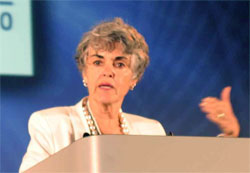Partnering in the Context of Learning
<< back to Simulation National Leadership Conference 2010 Home page

Wed. 9/15/2010 - AM
Wednesday morning during the plenary session of the Simulation National Leadership Conference, Dr. Robert Jesse, Principle Deputy Under Secretary for Health, spoke about the VHA SimLEARN strategic plan. He stressed that SimLEARN plays a supportive role for the wider VHA mission as well as sustaining rapid improvement of the use of simulation in medical education. He included light-hearted video clips of overzealous standardized patients to reinforce his points. As he went through the program's goals, Dr. Jesse discussed the evolution of the SimLEARN National Center by explaining that it is built upon a great deal of thought and planning.
Then Dr. Geraldine Bednash, Chief Executive Officer and Executive Director of the American Association of Colleges of Nursing, took the podium for her fast-paced presentation "The Future of Simulation in Developing a Professional Workforce." Dr. Bednash began by framing a history of simulation in nursing with attention-grabbing personal anecdotes. She recalled taking turns playing the role of patients with her classmates in order to practice actual injections and IV techniques on one another. She then toured the landscape of how simulation affects nursing education. Dr. Bednash covered the disparity of resources available between nursing programs-issues of money, facilities, and faculty capable of supporting a curriculum that integrates simulation.
She highlighted how technology serves simulation for nursing education in several way
- It enhances opportunity for a wider spectrum of techniques and topics
- It helps create a structured pedagogy
- It overcomes unpredictable availability of patient care opportunity (for learning)
- It increases patient safety in a learning environment
She reflected that additionally, current and future nursing students are comfortable with technology use in most aspects of their lives-including education.
Dr. Bednash stressed that simulation is an inevitable element in the evolution of nursing education. With opportunities never before available, simulation�
- Helps with learning complex concepts and with multi-layered learning
- Strengthens problem-solving skills (as well as psycho-motor training)
- Provides education in authentic context for deeper learning and better retention
Her capstone point concerned ideas related to teaming. Nurses must engage in simulation-based education with an interdisciplinary team because teaming is the normal context in healthcare. In addition, simulation programs should be capable of teaming with other institutions-a cooperative enterprise-in order to share valuable (and often expensive) resources, facilities, and knowledge. "Partnership, partnership, partnership is absolutely essential." In other words, use of simulation in nurse education is deeper than an a la carte selection of simulation activities for learners. To this point, Dr. Bednash wrapped up with a quote from Starkweather & Kardong-Edgren (2008) "It is not solely the use of simulation, but the techniques employed with simulation that can improve the teaching experience for faculty and students."



















